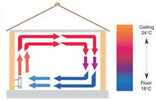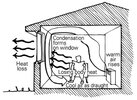Hi folks,
This question has been asked before in one way or another, but I'd be grateful for current views...
I'm trying to make decisions about placement of CH radiators in a house that currently has none. A couple of the rooms have internal sills (or is it cills? ) that protrude about 100mm inboard of the wall It's a bit messy at the moment, but pic below gives an idea.
) that protrude about 100mm inboard of the wall It's a bit messy at the moment, but pic below gives an idea.
The curtain will be above the sill (as is the net curtain in piccie), so will not get in the way of the radiator. Is it adequate to mount a radiator on the wall, in the usual way, with a gap between the top of radiator and the sill (I've seen gaps of both 50mm and 100mm recommended) or would it be desirable/better to move the radiator out further from the wall?
Thanks for your advice,
Kind Regards, John
This question has been asked before in one way or another, but I'd be grateful for current views...
I'm trying to make decisions about placement of CH radiators in a house that currently has none. A couple of the rooms have internal sills (or is it cills?
The curtain will be above the sill (as is the net curtain in piccie), so will not get in the way of the radiator. Is it adequate to mount a radiator on the wall, in the usual way, with a gap between the top of radiator and the sill (I've seen gaps of both 50mm and 100mm recommended) or would it be desirable/better to move the radiator out further from the wall?
Thanks for your advice,
Kind Regards, John



